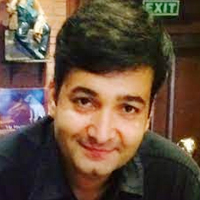Coronavirus and pH
Published on: 1st June, 2023
This article investigates the viability of SARS-CoV-2 and its dependence on pH levels, specifically focusing on the difference between the pH stability intervals for the coronavirus and human blood. Human blood typically maintains a pH range of around 7.35 to 7.45, while SARS-CoV-2 exhibits stability within the pH range of 6.0 to 6.5. The study aims to elucidate the critical role of hemoglobin in maintaining pH balance and explores its implications for viral susceptibility. The findings emphasize the importance of reinforcing the alkalinity of the medium as a means to weaken the virus. The research contributes to the understanding of pH-dependent mechanisms in viral infections and provides valuable insights for the development of potential therapeutic strategies.
‘Rotational alignment on patients’ clinical outcome of total knee arthroplasty: Distal femur axillary X-ray view to qualify rotation of the femoral component
Published on: 4th May, 2020
OCLC Number/Unique Identifier: 8588740322
Background: Rotation of the femoral component in total knee replacement (TKR) is very important for good long-term results. Malrotation of the femoral component usually requires subsequent reimplantation. We performed X-ray projections of the knee at 90° to determine proper rotation of the femoral component without use of computed tomography.
Methods: The axial projection of the distal femur was measured in post-TKR cases. During the TKR operation, Whiteside’s method had been used to provide symmetrical flexion space. The exact outer rotation of the femoral component was measured by x-ray determination of the middle condylar twist angle, from the central epicondylar axis and posterior condylar axis.
Results: The middle condylar twist angle was in outer rotation, with an average of 3.36° (range: 1-7.6), similar to the literature. Six of the patients underwent bilateral TKR. In total, the case series included 18 women and 15 men, with average age of 71.34 years-old (range: 56-85). As a clinical evaluation we used Knee Society Score (2011). From results 2 patients were not very satisfied with the instability TKR. Axially X-ray seemed to be only which could distribute these patients.
Summary: X-ray values have the same evaluation as computed tomography. The results were 2 patients in pattern of 48, which were sufficient to extrapolate to whole population according to the statistical methods. This corresponds to 4% which we can add to evaluate satisfaction of all patients after TKR and eventually lower the total of unsatisfactory patients which is total of ¼ of total. It is also forensic reason for all patients. Our recommendation to have good results and patient satisfaction in TKR is to do x-rays before and after operation. Important are x-rays antero-posterior, lateral, and Kanekasu projection to know the rotation after TKR. Other cases without stability in flexion are nor very rarely planed for revision surgery, which is much more expensive, and burdens overall health system.
A Study of excitation functions in the interaction of α + 59Co system at 4~9MeV/Nucleon
Published on: 1st March, 2022
In this work, α-induced 59Co reactions in the energy range from 11- 41MeV were used in order to study the role of pre-equilibrium emission. The experimentally measured excitation functions for residues populated via (α, n),(α, 2n),(α,3n),(α,2p),(α, 3n 2p) and (α, 4n 2p) channels in the interaction of + 59Co system available in the literature [13] were compared with theoretical predictions obtained using the statistical model code COMPLET. It was observed that at higher energy points the pure compound nucleus predictions, in general, failed to reproduce the measured data at projectile energies ~11-41MeV, this shows significant contributions from pre-equilibrium emission. The study signified both equilibrium and pre-equilibrium emissions were required to reproduce the presently measured excitation functions. An attempt was made to deduce the contribution coming from pre-equilibrium emission. It was found that the pre-equilibrium contribution increases with increasing projectile energy. Furthermore, the present result revealed a strong correlation between pre-equilibrium contribution and particle multiplicity.
Correlation between chronic inflammation of rheumatoid arthritis and coronary lesions: “About a monocentric series of 202 cases”
Published on: 6th December, 2022
Introduction: Cardiovascular diseases are the leading cause of death in the world, headed by coronary artery disease, which is secondary to atherosclerosis. The latter recognizes classic risk factors such as diabetes, high blood pressure, tobacco, and dyslipidemia and other less classic factors such as chronic inflammation of rheumatoid arthritis. Many studies have highlighted the correlation between this chronic inflammation and clinical coronary disease but very few have focused on the anatomical correlation. Objective: To describe the correlation between the chronic biological inflammation of rheumatoid arthritis and anatomical coronary lesions on angiography. Method: This observational, retrospective, single-center study, including over 10 years, of patients with rheumatoid arthritis, confirmed the EULAR 2010 criteria and presented with coronary artery disease requiring coronary angiography. Patients with missing data or in whom coronary angiography was not done were excluded (n = 14). We divided then the patients according to the existence or not of chronic inflammation to study the impact of the latter on the existence (Stenosis < 50% vs. stenosis ≥ 50%), the extent (single vs. multivessel disease), and the severity of the coronary lesions (syntax score < 32 vs. ≥ 32). Results: 202 patients (49♂/153♀) aged between 30-75 years with a history of rheumatoid arthritis have had a coronary event requiring coronary angiography, were included; The mean ejection fraction at baseline was 57.3% +/- 5.8 (37 vs.-65%). 75% of them were ≥ 65 years old. 55% were diabetics, 61% with hypertension, 38% with dyslipidemia, and 19% were smokers. Chronic inflammation was diagnosed in 70% of them on non-specific parameters (ESR, CRP, fibrinogen, anemia, and rheumatoid factor). All patients had coronary angiography, which made it possible to identify the coronary lesions according to their existence (Stenosis < 50%: 51 patients vs. stenosis ≥ 50%: 151 patients), the extent (single: 86 patients vs. multivessel disease: 116 patients) and the severity of the coronary lesions (syntax score < 32: 142 patients vs. ≥ 32: 60 patients). Chronic inflammation of rheumatoid arthritis was correlated in bivariate and multivariate analysis (after excluding the impact of other risk factors) with the existence and extent of coronary lesions (p < 0.05) but not with their severity (p > 0.05). Discussion: The two limitations of this work are the monocentric nature of the study and the absence of specific inflammatory parameters such as anti-CCP antibodies. Strengths are anatomical correlations and multivariate analysis. Chronic inflammation apart from any influence of the various risk factors predisposes to the existence and extent of coronary lesions (p < 0.05). The severity of coronary lesions assessed by Syntax Score was not correlated with chronic inflammation, although other studies suggest that this inflammation is the cause of complex lesions.Interpretation: Rheumatoid arthritis is associated with an increase in cardiac morbidity and mortality. Atheromatous lesions are more frequent in those patients than the existence of classic cardiovascular risk factors would suggest. Several explanations could account for this risk: the inflammatory syndrome and its impact on the cardiovascular risk factors and the vessel and the deleterious effect of the treatments. This requires stricter screening and management of risk factors in rheumatoid arthritis.
Sequence-independent single-primer-amplification (SISPA) as a screening technique for detecting unexpected RNA viral adventitious agents in cell cultures
Published on: 12th March, 2021
OCLC Number/Unique Identifier: 8982622827
The sequence-independent, single-primer amplification (SISPA) enables the random amplification of nucleic acids, allowing the detection and genome sequencing of different viral agents. This feature of SISPA method provides evidence for application of it in monitoring the presence of adventitious RNA viruses in cell cultures. We evaluated SISPA method for the detection of a challenge RNA virus representing adventitious agent in cell cultures. Besides, by optimizing the SISPA method in our laboratory, we found false-positive results on negative control lanes in electrophoresis gels. To investigate the sources of contamination, false-positive results of SISPA were cloned into Escherichia coli cells, sequenced, and phylogenetically analyzed. This data revealed that the SISPA method can be used as an adjunct method to confirm the absence of unexpected adventitious RNA viruses in cell cultures. The phylogenetic analysis of SISPA contaminant sequences showed that the false-positive results were caused by nucleic acid amplification of commercial cDNA synthesis kit reagents, probably tracing back to expression plasmids and host ribosomal sequences, used for the production of enzymes. Therefore, laboratories using random amplification methods must be constantly aware of the potentials of such contaminations, yielding false-positive results and background noise in the final NGS reads.
The choice of optimal modern muscle relaxants (rocuronium bromide, atracurium besilate and cisatracurius besilate) in one-day surgery in children
Published on: 15th June, 2020
OCLC Number/Unique Identifier: 8633140096
The choice of the optimal muscle relaxant in one-day surgery in children with “small” surgical interventions remains relevant to this day. In modern pediatric surgery, the requirements for the quality of muscle relaxation are highest. However, along with the effectiveness of the drug, its duration and controllability of the action, as well as the safety of use, are important [1-7].
The aim of the study: To determine the pharmacoeconomic rationale for the rational use of muscle relaxants, depending on the duration of operations in one-day surgery in children.
Material and research methods: The study was conducted in surgical clinics of the Azerbaijan Medical University. The study included 156 children who were operated on routinely from 0 to 16 years old (risk of anesthesia I-II ASA), who used combined endotracheal anesthesia during surgery. Based on the requirements of the GCP international program (Good Clinical Practice), the inclusion of children in the study was carried out only after the written consent of the parents. The studied patients were divided into 3 groups depending on the muscle relaxant used: IA (n = 52) - rocuronium bromide (esmeron), IB (n = 52) - atracurium besilate (tracrium), IC (n = 52) - cisatracurius besilate (nimbex). Depending on the type of general anesthesia, these groups were also divided into 2 subgroups: anesthesia based on isoflurane + fentanyl ″ + iso ″ and anesthesia based on sevoflurane + fentanyl ″ + sev ″. The main groups were also divided into 2 age subgroups: children under 2 years of age – IA1, IB1, IC1 and children from 2 to 16 years old – IA2, IB2, IC2.
Cannabinoids as a yield modifier in physical activit: A systematic review characters
Published on: 28th July, 2021
OCLC Number/Unique Identifier: 9272370672
Marijuana is considered illicit in much of the world, and is classified as a drug for recreational use, in recent decades the medicinal use of Cannabis sativa L. has grown and diversified, being considered the only therapeutic alternative in the control of serious and incurable diseases such as syndrome of Dravet. The world panorama has shown a more liberal position, since in several countries such as the United States of America, Holland, Australia, Italy, and more recently in Canada, the use of medications, or even the recreational use of this plant, have been regulated. In this context, the investigation of the modifying effects on physical activity of empirically used cannabinoids is fundamental nowadays, mainly due to the regulatory recognition of Cannabis sativa L. as a medicinal plant in a large part of the world. Therefore, the objective of this review was to verify the evidence related to the effect of cannabis on physical performance and to identify and highlight the challenges in the interpretation of information regarding the performance of practitioners of physical activity, as well as athletes, presenting new trends in this area of research to be addressed. To carry out the systematic review, a bibliographic survey of case reports was obtained through Pubmed, Science Direct and Google Academic databases. The following keywords were used to perform the research: cannabis, performance, pain, competition. The following filters were used as inclusion criteria a languages used english; species: humans; types of articles: original articles and reviews and period of publication of articles: 1981 to 2021.
New insights from cardiac muscle applied to skeletal muscle
Published on: 15th January, 2021
OCLC Number/Unique Identifier: 8897946095
I have recently described the origin of the second Ca2+ binding in the triggering of contractile activity in cardiac myofibrils that is the origin of the Ca2+ Hill coefficient of 2 for the ATPase. This site is not a simple protein binding site and cannot be measured by 45Ca2+ binding. The myofibril protein unit requirements are described by me and so are the consequences of disruption of the function of these units and the related medical outcomes. The purpose of this paper is to review the topic and extend the reasoning to the function of skeletal muscle and cite the literature that supports this.
RBD targeted COVID vaccine and full length spike-protein vaccine (mutation and glycosylation role) relationship with procoagulant effect
Published on: 26th April, 2021
OCLC Number/Unique Identifier: 9026719857
Related COVID vaccine production many different strategies was followed by the producers.
Observing some rare event of thrombosis after some COVID-19 vaccination, it is interesting to verify if the Target used for the manufacturing can be involved in a different procoagulant activity or not.
Some vaccine are suspended in some country or under a deep new verify- investigation by the regulatory agency. (EU or USA).
This fact it is relevant.
The target SPIKE-PROTEIN FULL LENGTH modified or not or towards the RBD domain can be a relevant factor.
Why? It is the question that I ask myself every day, every hour, every second...
Published on: 22nd March, 2021
OCLC Number/Unique Identifier: 9031334722
It is the dart that penetrates deep into my soul, every time I see with my own eyes how the incidence of cancer has grown in recent years. I am a pathologist. I am dedicated to diagnosing the disease from the cellular and tissue point of view. The answer to the question that haunts me may seem easy, simple, but I am not satisfied with knowing that advances in technology make it possible to diagnose a greater number of entities, many of them in early stages [1]. Of course, this statement is true. However, in recent years we have verified a greater number of cases with aggressive phenotypes, a fact that makes us ask ourselves certain questions. The first one is: Why?
We know that cancer is a multifactorial disease in which genetics and different environmental factors participate. Are we witnessing the concurrence of factors that facilitate the greatest degree of neoplasms? Are habits the cause of this paradigm shift? On the table for debate is the therapeutic success of new strategies, of new drugs, of new algorithms, but the morphology is also changing. This change is exacerbated in the times of pandemic that we have lived through [2]. Pathologists attend a number of cancer diagnoses that have grown exponentially, as has the histological grade, not the staging, of it. And the initial question remains in the air, why?
The fear of going to the hospital, the fear of self-exploration, the diversion of media attention to topics that arouse greater interest ... may be having a harmful effect on the health of patients [3].
I do not tell anything new, at least nothing that cannot be assumed by analyzing what happens every day in this new world, a world that will soon have to face, if not already, a cut in resources, research and other parameters that will negatively influence the answers to the eternal question: Why?
In the era of personalized medicine, the same one that has reached or is close to reaching great milestones in the survival of once-deadly diseases, the microscope shows a parallel reality and allows, at least, to be pessimistic, or at least realistic: suffering…
















